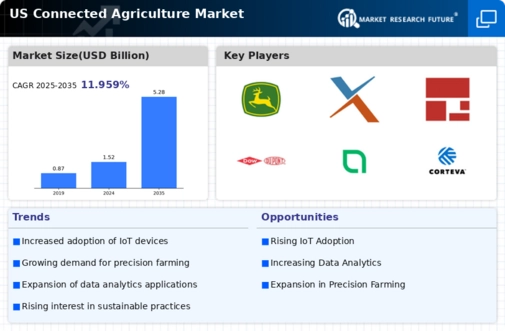Advancements in Agricultural Robotics
The connected agriculture market is witnessing significant advancements in agricultural robotics, which are transforming traditional farming practices. Robotics technology, including autonomous tractors and drones, is being integrated into farming operations to improve efficiency and reduce labor costs. These innovations allow for tasks such as planting, harvesting, and monitoring crops to be performed with greater precision and speed. The market for agricultural robots is projected to grow substantially, with estimates suggesting a compound annual growth rate (CAGR) of over 25% in the coming years. This trend indicates a shift towards automation in agriculture, further driving the connected agriculture market.
Rising Demand for Precision Agriculture
The connected agriculture market is experiencing a notable surge in demand for precision agriculture techniques. Farmers are increasingly adopting technologies that enable them to monitor crop health, soil conditions, and weather patterns in real-time. This shift is driven by the need to optimize resource use and enhance yield. According to recent data, precision agriculture can lead to yield increases of up to 20%, which is particularly appealing in a competitive market. The integration of sensors, drones, and satellite imagery allows for more informed decision-making, thereby improving overall farm productivity. As a result, The connected agriculture market is likely to expand. This expansion will occur as more farmers recognize the benefits of precision farming methods.
Government Support and Funding Initiatives
Government initiatives play a crucial role in the growth of the connected agriculture market. Various federal and state programs are designed to support the adoption of advanced agricultural technologies. For instance, funding opportunities for research and development in smart farming technologies have increased significantly. The USDA has allocated millions of dollars to promote innovation in agriculture, which includes grants for farmers to implement connected technologies. This financial backing not only encourages farmers to invest in new solutions but also fosters a more robust ecosystem for technology providers. Consequently, the connected agriculture market is poised for growth as government support continues to bolster technological advancements.
Integration of Big Data and AI Technologies
The integration of big data and artificial intelligence (AI) technologies is reshaping the connected agriculture market. Farmers are increasingly leveraging data analytics to make informed decisions regarding crop management and resource allocation. By analyzing vast amounts of data from various sources, including weather forecasts and soil sensors, farmers can optimize their operations and improve yields. The use of AI algorithms can predict crop performance and identify potential issues before they escalate. This data-driven approach is expected to enhance productivity and sustainability in agriculture, thereby propelling the connected agriculture market forward.
Consumer Demand for Transparency and Traceability
In the connected agriculture market, there is a growing consumer demand for transparency and traceability in food production. Consumers are increasingly interested in knowing the origins of their food and the methods used in its production. This trend has prompted farmers to adopt connected technologies that provide real-time data on crop production and supply chain processes. By utilizing blockchain and IoT solutions, producers can offer detailed insights into their farming practices, thereby enhancing consumer trust. As a result, the connected agriculture market is likely to benefit from this shift, as more producers seek to meet consumer expectations for transparency.






















Leave a Comment